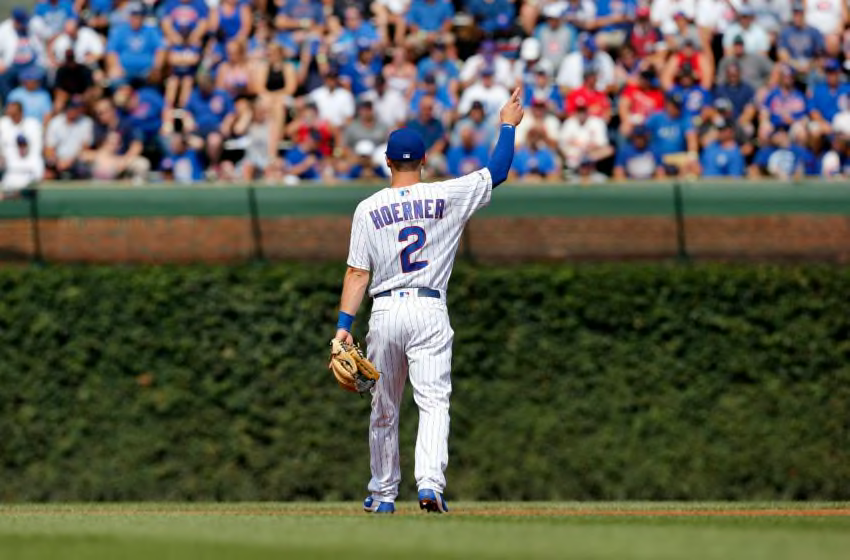
CHICAGO, ILLINOIS – SEPTEMBER 20: Nico Hoerner #2 of the Chicago Cubs signals one out during the first inning of a game against the St. Louis Cardinals at Wrigley Field on September 20, 2019 in Chicago, Illinois. (Photo by Nuccio DiNuzzo/Getty Images)
Cubs top prospect Nico Hoerner shined in 20 games last season in Chicago ,but can the 23-year-old continue to develop properly while also contributing to the big-league club in 2020?
Last season, the Chicago Cubs were in desperate need of a shortstop after both Javier Baez and Addison Russell suffered injuries. The Cubs were left with few choices and decided to fast-track top prospect Nico Hoerner, who turned heads quickly after an impressive Wrigley Field debut.
Hoerner’s aggressive approach in his small sample of 20 games last season generated some memorable moments in a Cubs uniform but it also exposed some flaws in Hoerner’s game. Hoerner was second on the team last year in contact, connecting on 81.9 percent of his big-league swings.
For a team like the Cubs, who were tied with the Tigers for the lowest contact percentage last season, Hoerner’s presence in the lineup put a band-aid on the Cubs disappointing offense for a few weeks. But Hoerner’s approach at the plate eventually started to hurt him, expanding the strike zone, swinging less at pitches in the zone – all things young players go through.
At the end of Hoerner’s 20-game cup of coffee with the Cubs, he had collected 22 hits, scored 13 runs, but had taken just three walks and struck out 11 times. But according to Hoerner, his over-aggressive gameplan was on purpose.
In an article from Jordan Bastian of MLB.com, Hoerner explains how his approach in the batter’s box was his way of adjusting to the level of play in the Major Leagues.
“I went into it wanting to be aggressive. I knew that mistakes would come with that, but I didn’t want to be passive about it. And with that came, I didn’t control the strike zone — like, at all. So, that’s definitely something I know I can get better at.”
Bastian goes on to point out that Hoerner’s numbers support the claim, as he swung outside the strike zone around 10 percent more than the average major league hitter, as well as a slightly above average swing rate at pitches in the zone.
And while teams began to recognize Hoerner’s hyper-aggressive approach and use it against him, the 23-year-old has shown in his short time with the Cubs his ability to adjust on the fly. The fact he was making his Major-League debut barely a year after he was drafted is enough to show Hoerner is capable of making the necessary changes in his game to stick at the MLB level.
Before the MLB season was put on hold, the Cubs were in the midst of deciding who was going to be the team’s primary second baseman, with Hoerner very much still in the mix. Should MLB and the MLBPA come to an agreement for a 2020 season, rosters are expected to be expanded which should lock up a spot for Hoerner on the MLB roster.
Cubs need another contact bat in their lineup with Ben Zobrist leaving the team in free agency this offseason. And with no clear option to replace Zobrist and the assumed addition of the DH in the National League this season, the Cubs should have the flexibility to fit Hoerner and his bat-to-ball skills into the lineup.
“I have a lot of confidence in my swing itself,” Hoerner said. “That’s something that will always evolve, and I think the more chances I give myself to hit good pitches, that will take me a long way.”
New manager David Ross will have a tough time figuring out how to navigate a shortened season, but if Hoerner can continue to adjust to the major league at the rate he has shown throughout his professional career, the Stanford product will be a crucial part of the Cubs offense in 2020.